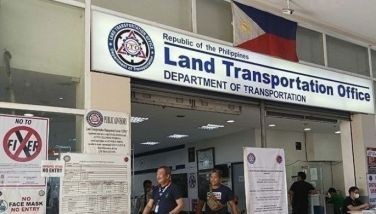Improving connectivity and making first impressions last
MANILA, Philippines — The Philippines is hoping to permanently erase negative impressions of the past about the country’s airports and eventually build new good ones to last. The international travel community has started taking notice of the developments being undertaken by the government and the private sector, recognizing some of the country’s gateways as among the best and most improved Developments have not escaped the sights of the local business sector either.
“I have seen a lot of progress already,” Lance Gokongwei, president of Cebu Pacific operator Cebu Air Inc., said. “We can see that the government is in very good financial footing and it’s really putting the
money in the long-term stuff that is necessary such as infrastructure, airports, and the like. The government is very committed and we must support them,” Gokongwei said.
When talking about Philippine airports, the Ninoy Aquino International Airport (NAIA), the country’s main international gateway in Pasay City, is top of mind. Due to poor facilities, congestion, security concerns, bribery, and other issues such as the laglag-bala or bullet planting for extortion and bukas-bagahe or baggage pilferage modus, NAIA for several years was a mainstay in the world’s worst airport list.
Accolades
Things turned around last year when the international airport was ranked as the 10th most improved airport in the world by international air transport rating organization Skytrax. Last June, a survey released by Blacklane, a global chauffeur and airport concierge service, positioned NAIA as the seventh fastest Asia-Pacific airport to exit for international arrivals, taking an average of 37 minutes to exit. The measurement covers the total time for travelers to exit the aircraft, gather their luggage, secure clearance in immigration and customs, and walk to their waiting vehicles Some of the important factors cited for the short exit time are the substantial deployment of airport employees to accommodate passengers, as well as new technology such as e-gates that speed up travelers’ exit.
Just recently, NAIA’s improvements were again recognized as it was ranked 44th on the world’s best airports for business travelers list by United Kingdom’s business class flight specialist Globehu nter,
which looked into factors such as facilities, services offered, cost of parking, and number of lounges available, among others.
But while the days of the laglag-bala modus are long gone and issues on security concerns and bribery have diminished, congestion continues to persist in the airport, often resulting in flight delays and irate passengers. The government, through the Department of Transportation (DOTr) and its attached agencies, is working on decongesting NAIA through ongoing upgrades on the airport’s facilities and rehabilitation of its Terminal 2. NAIA Terminal 1, meanwhile, now includes new glass aerobridges and two rapid taxiways.
Rehabilitation work on Terminal 2 include the expansion of departure check-in hall and arrival baggage area, architectural improvements in passenger movement areas, upgrade of aerobridge areas and elevated roadway, new glass wall panels and partitions, among others.
To complement these physical developments, the DOTr last month was able to encourage local airlines to sign a pledge of commitment to rationalize flight num bers, aircraft movement and rotation, as well as the usage of slots and flying rights, to improve on-time performance and decongest NAIA.
New Gateways
A consortium of seven conglomerates composed of Aboitiz InfraCapital, ACInfrastructure Holdings Corp., Alliance Global Group Inc., Asia’s Emerging Dragon Corp., Filinvest Development Corp., JG Summit Holdings Inc., and Metro Pacific Investments Corp. has also submitted a P102-billion proposal to rehabilitate, upgrade, expand, operate and maintain the NAIA for 15 years.
The proposal, which is still being evaluated, seeks to expand and interconnect the existing terminals of NAIA, upgrade its airside facilities, develop commercial facilities to increase airline and airport efficiencies, enhance passenger comfort and experience, and elevate the status of the airport as the country’s premier international gateway.
But as the NAIA rehabilitation continues, the government is also working to free up capacity at the main gateway through complementary infrastructure development. The proposed New Manila International Airport in Bulacan is among those seen to significantly help decongest passenger traffic at NAIA once built. The new airport, which San Miguel Corp. is proposing to develop, is targeted to be operational within four to six years from its target start of construction. Additional facilities at the Sangley Airport in Cavite were likewise ordered to be under 24/7
construction in order to meet the November deadline of President Duterte for the military air base to commence general aviation and turboprop operations.
Construction is also ongoing for the second passenger terminal building of the Clark International Airport, which will increase the gateway’s overall capacity to 12.2 million passengers annually once it opens by the middle of 2020. An additional runway is also set for construction.
The Clark International Airport was awarded a two-star on-time performance rating last year, and it looks forward to receiving another two star award from the Official Aviation Guide after garnering 75.3 percent on-time performance rating from June 2018 to May 2019. NAIA is not the sole airport in the country to receive recent accolades.
The Mactan-Cebu International Airport (MCIA), dubbed as the country’s friendliest resort airport, has also been recognized by two international awards-giving bodies in architecture for the design of Terminal 2, its international terminal.
MCIA Terminal 2 was one of the winners in the 2019 International Architecture Awards in the Airports and Transportation Centers category, and was also shortlisted for the upcoming World Architecture Festival in Amsterdam.
Last year, the MCIA, which is managed by GMR Megawide Cebu Airport Corp., received three awards, one of which is the Asia Pacific Medium Airport of the Year at the CAPA Aviation Awards for Excellence, one of the most respected awards in the airport and aviation industry. Transportation Secretary Arthur Tugade, however, pointed out that improvements being undertaken on the country’s airports are not meant for awards and recognitions, but are geared toward enhancing the comfort and convenience of the air-riding public, as aspired for by President Duterte himself.
“Remember, we are an archipelago and therefore there’s got to be mobility by air,” Tugade said. “That’s why one thing we are doing is night-rating the capacity of our airports. In the past, most of the commercial airports stop
operations at sunset. So what we did was to increase mobility by putting or making our airports night-rated so that they can still oper- ate after sunset,” he said.
A total of 21 of the country’s airports have been night-rated under the Duterte administration, with 15 more to be night-rated by the end of the President’s term. In the first half of the current administration, the DOTr and the Civil Aviation Authority of the Philippines completed 17 commercial airport projects, including two new international airports, namely the Lal-Lo International Airport in Cagayan, and the country’s first eco-airport, the Bohol-Panglao International Airport. A total of 15 other existing gateways have also been upgraded, two of which are international
and 13 domestic. The rehabilitated international airports are the MCIA, which boosted its annual capacity to 13.5 million passengers, and the Puerto Princesa Airport, which now has an expanded passenger terminal building and an extended runway to accommodate larger aircraft.
But the government is not stopping any time soon, knowing that much remains to be done to provide a pleasant and hassle-free airport experience. As a testament to the government’s continuing drive for air connectivity, the DOTr said it is accelerating the ongoing infrastructure development of 27 commercial airports nationwide.
The Bicol International Airport, which is now more than halfway complete, is expected to accommodate two million passengers per year once completed in 2020. International airports in Davao, General Santos, Zamboanga, Iloilo, Kalibo, and Laoag are also undergoing improvements, while development projects continue for domestic airports in Busuanga, Cauayan, Naga, and Tuguegarao in Luzon; Bacolod-Silay, Calbayog, Catbalogan, Dumaguete, and Tacloban in Visayas; and Bukidnon, Ipil, Laguinduingan, Mati, M’lang, Ozamiz, Sanga-Sanga, Siargao, and Surigao in Mindanao.
A number of regional airports have also received unsolicited proposals to be operated, maintained and expanded by the private sector. Proposals have been submitted by Chelsea Logistics Holdings Corp. for Davao International Airport, Udenna Infrastructure Corp. for the Bacolod-Silay Airport and Busuanga Airport in Palawan, the Aboitiz Group for the New Bohol (Panglao) International Airport and Laguindingan Airport, Prime Asset Ventures Inc. of the Villar group for the Puerto Princesa airport and Iloilo International airport, and Mega7 Construction Corp. for the Kalibo International Airport.
Tugade said building new airports and rehabilitating existing ones are essential in bringing national progress, as gateways would provide much needed connectivity and mobility in transport to all Filipinos.
“I want the farthest regions and the farthest provinces to be connected with one another, and integrated to Metro Manila,” Tugade said.
- Latest
- Trending































